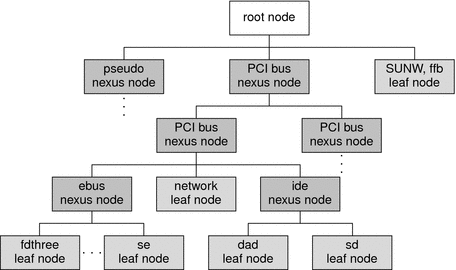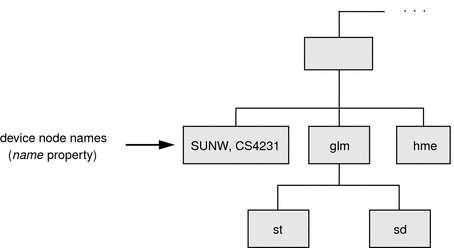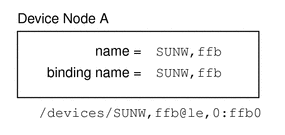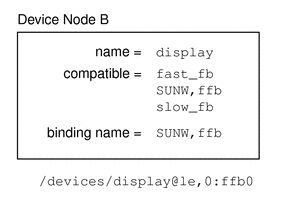|
|||
|
Part I Designing Device Drivers for the Solaris Platform 1. Overview of Solaris Device Drivers 2. Solaris Kernel and Device Tree 5. Managing Events and Queueing Tasks 7. Device Access: Programmed I/O 10. Mapping Device and Kernel Memory 14. Layered Driver Interface (LDI) Part II Designing Specific Kinds of Device Drivers 15. Drivers for Character Devices 18. SCSI Host Bus Adapter Drivers 19. Drivers for Network Devices Part III Building a Device Driver 21. Compiling, Loading, Packaging, and Testing Drivers 22. Debugging, Testing, and Tuning Device Drivers 23. Recommended Coding Practices B. Summary of Solaris DDI/DKI Services C. Making a Device Driver 64-Bit Ready |
Overview of the Device TreeDevices in the Solaris OS are represented as a tree of interconnected device information nodes. The device tree describes the configuration of loaded devices for a particular machine. Device Tree ComponentsThe system builds a tree structure that contains information about the devices connected to the machine at boot time. The device tree can also be modified by dynamic reconfiguration operations while the system is in normal operation. The tree begins at the root device node, which represents the platform. Below the root node are the branches of the device tree. A branch consists of one or more bus nexus devices and a terminating leaf device. A bus nexus device provides bus mapping and translation services to subordinate devices in the device tree. PCI - PCI bridges, PCMCIA adapters, and SCSI HBAs are all examples of nexus devices. The discussion of writing drivers for nexus devices is limited to the development of SCSI HBA drivers (see Chapter 18, SCSI Host Bus Adapter Drivers). Leaf devices are typically peripheral devices such as disks, tapes, network adapters, frame buffers, and so forth. Leaf device drivers export the traditional character driver interfaces and block driver interfaces. The interfaces enable user processes to read data from and write data to either storage or communication devices. The system goes through the following steps to build the tree:
Each driver exports a device operations structure dev_ops(9S) to define the operations that the device driver can perform. The device operations structure contains function pointers for generic operations such as attach(9E), detach(9E), and getinfo(9E). The structure also contains a pointer to a set of operations specific to bus nexus drivers and a pointer to a set of operations specific to leaf drivers. The tree structure creates a parent-child relationship between nodes. This parent-child relationship is the key to architectural independence. When a leaf or bus nexus driver requires a service that is architecturally dependent in nature, that driver requests its parent to provide the service. This approach enables drivers to function regardless of the architecture of the machine or the processor. A typical device tree is shown in the following figure. Figure 2-2 Example Device Tree The nexus nodes can have one or more children. The leaf nodes represent individual devices. Displaying the Device TreeThe device tree can be displayed in three ways:
Note - /devices displays only devices that have drivers configured into the system. The prtconf(1M) command shows all device nodes regardless of whether a driver for the device exists on the system. libdevinfo LibraryThe libdevinfo library provides interfaces for accessing all public device configuration data. See the libdevinfo(3LIB) man page for a list of interfaces. prtconf CommandThe following excerpted prtconf(1M) command example displays all the devices in the system. System Configuration: Sun Microsystems sun4u
Memory size: 128 Megabytes
System Peripherals (Software Nodes):
SUNW,Ultra-5_10
packages (driver not attached)
terminal-emulator (driver not attached)
deblocker (driver not attached)
obp-tftp (driver not attached)
disk-label (driver not attached)
SUNW,builtin-drivers (driver not attached)
sun-keyboard (driver not attached)
ufs-file-system (driver not attached)
chosen (driver not attached)
openprom (driver not attached)
client-services (driver not attached)
options, instance #0
aliases (driver not attached)
memory (driver not attached)
virtual-memory (driver not attached)
pci, instance #0
pci, instance #0
ebus, instance #0
auxio (driver not attached)
power, instance #0
SUNW,pll (driver not attached)
se, instance #0
su, instance #0
su, instance #1
ecpp (driver not attached)
fdthree, instance #0
eeprom (driver not attached)
flashprom (driver not attached)
SUNW,CS4231 (driver not attached)
network, instance #0
SUNW,m64B (driver not attached)
ide, instance #0
disk (driver not attached)
cdrom (driver not attached)
dad, instance #0
sd, instance #15
pci, instance #1
pci, instance #0
pci108e,1000 (driver not attached)
SUNW,hme, instance #1
SUNW,isptwo, instance #0
sd (driver not attached)
st (driver not attached)
sd, instance #0 (driver not attached)
sd, instance #1 (driver not attached)
sd, instance #2 (driver not attached)
...
SUNW,UltraSPARC-IIi (driver not attached)
SUNW,ffb, instance #0
pseudo, instance #0
/devices DirectoryThe /devices hierarchy provides a namespace that represents the device tree. Following is an abbreviated listing of the /devices namespace. The sample output corresponds to the example device tree and prtconf(1M) output shown previously. /devices /devices/pseudo /devices/pci@1f,0:devctl /devices/SUNW,ffb@1e,0:ffb0 /devices/pci@1f,0 /devices/pci@1f,0/pci@1,1 /devices/pci@1f,0/pci@1,1/SUNW,m64B@2:m640 /devices/pci@1f,0/pci@1,1/ide@3:devctl /devices/pci@1f,0/pci@1,1/ide@3:scsi /devices/pci@1f,0/pci@1,1/ebus@1 /devices/pci@1f,0/pci@1,1/ebus@1/power@14,724000:power_button /devices/pci@1f,0/pci@1,1/ebus@1/se@14,400000:a /devices/pci@1f,0/pci@1,1/ebus@1/se@14,400000:b /devices/pci@1f,0/pci@1,1/ebus@1/se@14,400000:0,hdlc /devices/pci@1f,0/pci@1,1/ebus@1/se@14,400000:1,hdlc /devices/pci@1f,0/pci@1,1/ebus@1/se@14,400000:a,cu /devices/pci@1f,0/pci@1,1/ebus@1/se@14,400000:b,cu /devices/pci@1f,0/pci@1,1/ebus@1/ecpp@14,3043bc:ecpp0 /devices/pci@1f,0/pci@1,1/ebus@1/fdthree@14,3023f0:a /devices/pci@1f,0/pci@1,1/ebus@1/fdthree@14,3023f0:a,raw /devices/pci@1f,0/pci@1,1/ebus@1/SUNW,CS4231@14,200000:sound,audio /devices/pci@1f,0/pci@1,1/ebus@1/SUNW,CS4231@14,200000:sound,audioctl /devices/pci@1f,0/pci@1,1/ide@3 /devices/pci@1f,0/pci@1,1/ide@3/sd@2,0:a /devices/pci@1f,0/pci@1,1/ide@3/sd@2,0:a,raw /devices/pci@1f,0/pci@1,1/ide@3/dad@0,0:a /devices/pci@1f,0/pci@1,1/ide@3/dad@0,0:a,raw /devices/pci@1f,0/pci@1 /devices/pci@1f,0/pci@1/pci@2 /devices/pci@1f,0/pci@1/pci@2/SUNW,isptwo@4:devctl /devices/pci@1f,0/pci@1/pci@2/SUNW,isptwo@4:scsi Binding a Driver to a DeviceIn addition to constructing the device tree, the kernel determines the drivers that are used to manage the devices. Binding a driver to a device refers to the process by which the system selects a driver to manage a particular device. The binding name is the name that links a driver to a unique device node in the device information tree. For each device in the device tree, the system attempts to choose a driver from a list of installed drivers. Each device node has an associated name property. This property can be assigned either from an external agent, such as the PROM, during system boot or from a driver.conf configuration file. In any case, the name property represents the node name assigned to a device in the device tree. The node name is the name visible in /devices and listed in the prtconf(1M) output. Figure 2-3 Device Node Names A device node can have an associated compatible property as well. The compatible property contains an ordered list of one or more possible driver names or driver aliases for the device. The system uses both the compatible and the name properties to select a driver for the device. The system first attempts to match the contents of the compatible property, if the compatible property exists, to a driver on the system. Beginning with the first driver name on the compatible property list, the system attempts to match the driver name to a known driver on the system. Each entry on the list is processed until the system either finds a match or reaches the end of the list. If the contents of either the name property or the compatible property match a driver on the system, then that driver is bound to the device node. If no match is found, no driver is bound to the device node. Generic Device NamesSome devices specify a generic device name as the value for the name property. Generic device names describe the function of a device without actually identifying a specific driver for the device. For example, a SCSI host bus adapter might have a generic device name of scsi. An Ethernet device might have a generic device name of ethernet. The compatible property enables the system to determine alternate driver names for devices with a generic device name, for example, glm for scsi HBA device drivers or hme for ethernet device drivers. Devices with generic device names are required to supply a compatible property. Note - For a complete description of generic device names, see the IEEE 1275 Open Firmware Boot Standard. The following figure shows a device node with a specific device name. The driver binding name SUNW,ffb is the same name as the device node name. Figure 2-4 Specific Driver Node Binding The following figure shows a device node with the generic device name display. The driver binding name SUNW,ffb is the first name on the compatible property driver list that matches a driver on the system driver list. In this case, display is a generic device name for frame buffers. Figure 2-5 Generic Driver Node Binding
|
||
|